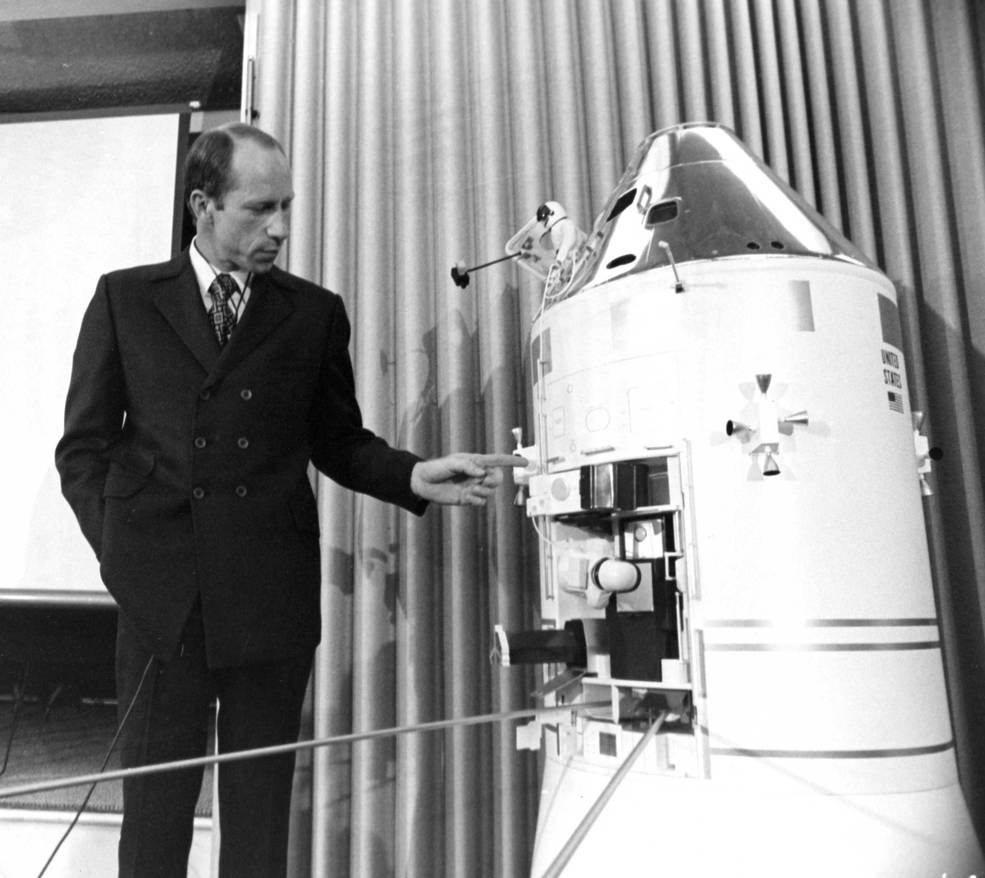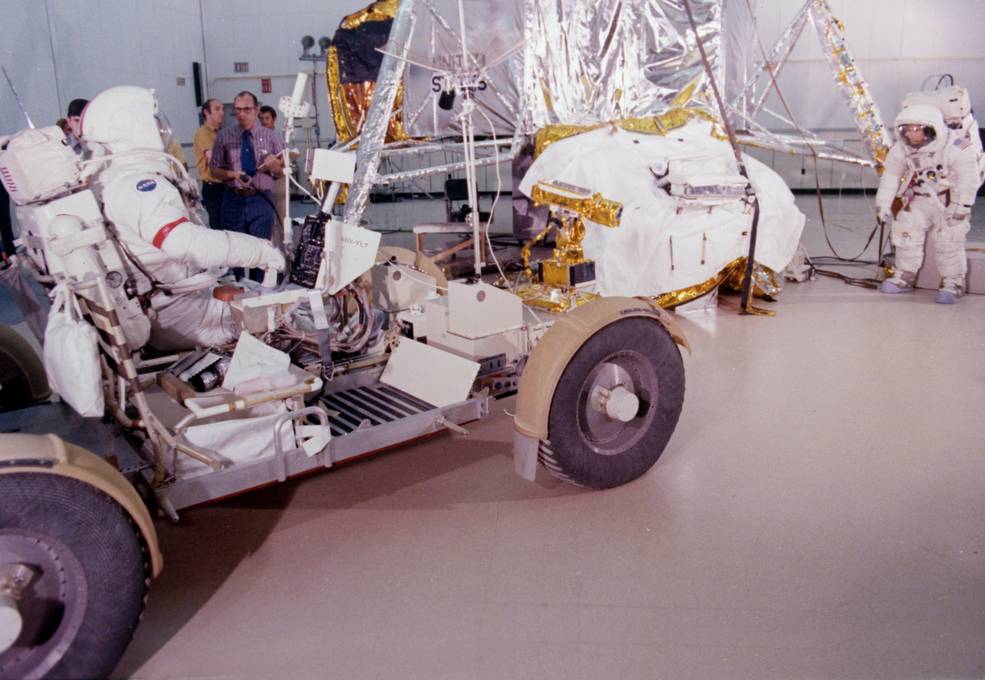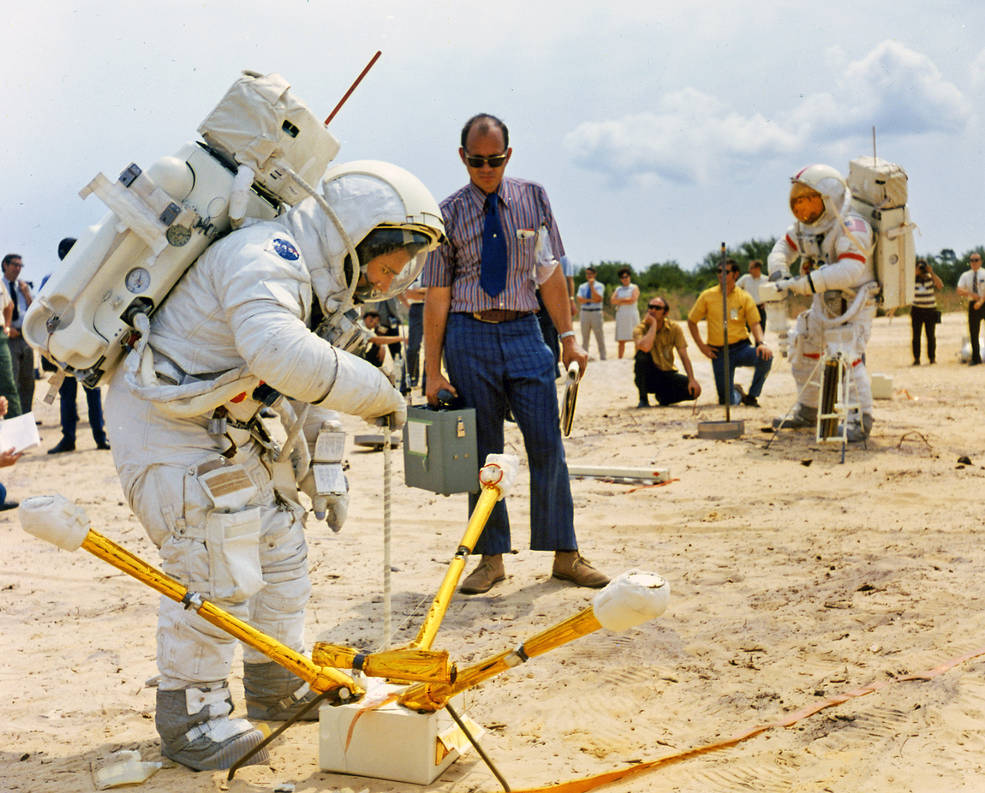With the Apollo 15 mission to the Moon only two months away, May 1971 proved a busy one for the prime crew of Commander David R. Scott, Command Module Pilot Alfred M. Worden, and Lunar Module Pilot James B. Irwin and their backups Richard F. Gordon, Vance D. Brand, and Harrison H. “Jack” Schmitt. At NASA’s Kennedy Space Center (KSC) in Florida, they attended the rollout of their Saturn V rocket to Launch Pad 39A where ground crews prepared the vehicle for the July 26 liftoff. The astronauts spent much of their time training for the lunar surface excursions using the Lunar Roving Vehicle and learning about lunar geology during several field trips. In the Gulf of Mexico, they practiced the post-splashdown recovery activities.




Left: Ground crews place the Apollo 15 spacecraft atop the Saturn V rocket in the Vehicle Assembly Building (VAB) at NASA’s Kennedy Space Center in Florida. Middle left: Apollo 15 astronauts James B. Irwin, left, Alfred M. Worden, and David R. Scott pose in front of their Saturn V rocket as it leaves the VAB. Middle right: The Apollo 15 Saturn V leaving the VAB. Right: The Apollo 15 Saturn V at Launch Pad 39A.
On May 8, 1971, workers in KSC’s Vehicle Assembly Building (VAB) stacked the Apollo 15 spacecraft, consisting of the Command and Service Module (CSM) and the Lunar Module (LM) inside the Spacecraft LM Adapter, atop the Saturn V rocket. Three days later, with Scott, Worden, and Irwin in attendance, the complete stack left the VAB for the 8-hour trip to Launch Pad 39A. Ground crews at the pad began to prepare the rocket and the spacecraft for the July 26, 1971 mission to land at the Hadley-Apennine site on the Moon, the furthest north of all the Apollo lunar landings. On May 4, Scott and Irwin demonstrated the Lunar Roving Vehicle (LRV) to assembled reporters at KSC, while Worden described the instruments of the SIM-bay, including the Particle and Fields Subsatellite that they released into lunar orbit, during a May 24 press conference.


Left: Apollo 15 astronauts James B. Irwin, left, and David R. Scott describe the features of the Lunar Roving Vehicle to reporters. Right: Apollo 15 astronaut Alfred M. Worden describes the Scientific Instrument Module bay using a model of the Apollo Service Module during a press conference.
During the 12-day mission, Scott, Worden, and Irwin planned to conduct five spacewalks – the first standup spacewalk on the lunar surface during which Scott would stand up through the LM’s top hatch to survey and photograph their surroundings, three lunar surface excursions using the Lunar Roving Vehicle for extended explorations, and the first cislunar spacewalk, conducted by Worden during the return trip from the Moon, to retrieve film canisters from the Scientific Instrument Module (SIM) bay in the Apollo spacecraft’s Service Module. Scott, Irwin, Gordon, and Schmitt conducted several training sessions to rehearse their lunar surface excursions, including the use of the LRV and the deployment of scientific experiments at the landing site. Scott and Gordon practiced landing the LM using the Lunar Landing Training Vehicle at Ellington Air Force Base near the Manned Spacecraft Center, now NASA’s Johnson Space Center in Houston. Worden and Brand rehearsed the cislunar spacewalk to retrieve film canisters from the SIM-bay. With the increased emphasis on science on Apollo 15, the astronauts participated in several geology training exercises. All six astronauts, along with support personnel and a team of geologists, traveled to the Coso Hills in California on Apr 29-30, where the moonwalkers practiced identifying geologic features during simulated lunar traverses while Worden and Brand conducted flyovers to identify sites of interest from the air, as they would from lunar orbit. The astronauts conducted similar activities during flyovers in northern California on May 14 and ground training at the Nevada Test Site on May 20-21.


Left: Apollo 15 astronauts David R. Scott, left, and James B. Irwin training for their lunar surface excursions using the Lunar Roving Vehicle (LRV). Right: Apollo 15 backup astronauts Richard F. Gordon, left, and Harrison H. “Jack” Schmitt training with the LRV for a lunar surface excursion.



Left: Apollo 15 astronaut James B. Irwin, left, trains on setting up the magnetometer experiment while David R. Scott sets up the lunar drill. Middle: Scott practicing on the use of the lunar drill. Right: Irwin trains on setting up the lunar surface experiments.
Like all previous crews before them, the Apollo 15 astronauts participated in splashdown recovery training activities in the Gulf of Mexico using the Motorized Vessel Retriever. On May 28, Scott, Worden, and Irwin climbed aboard a training version of an Apollo Command Module that Retriever’s sailors lowered into the water. The astronauts practiced exiting from the capsule and onto life rafts, assisted by a team of Underwater Demolition Team swimmers led by U.S. Navy Lt. Fred W. Schmidt. One by one, the astronauts climbed aboard Billy Pugh nets and crews aboard a hovering helicopter hoisted them aboard. Backups Gordon, Brand, and Schmitt conducted their egress training on June 7.


Left: Underwater Demolition Team swimmer for recovery operations Lt. Fred W. Schmidt, left, talks with Apollo 15 crew members Alfred M. Worden, James B. Irwin, and David R. Scott aboard the MV Retriever during recovery training. Right: During water recovery training in the Gulf of Mexico, Apollo 15 astronaut Scott is being hoisted aboard the recovery helicopter as his crewmates Irwin and Worden await their turn in the life raft.
To be continued…
World events in May 1971:
May 1 – Amtrak Railroad begins operations
May 1 – The Rolling Stones release “Brown Sugar”
May 3 – National Public Radio begins broadcasting
May 16 – U.S. first class postage raised from six cents to eight cents
May 17 – Steven Schwartz’s musical “Godspell” opens off-Broadway
May 30 – The United States launches Mariner 9, the first spacecraft to orbit Mars, joining the Soviet Union’s Mars 2 and 3 spacecraft on their journey to Mars
John Uri
NASA Johnson Space Center



























